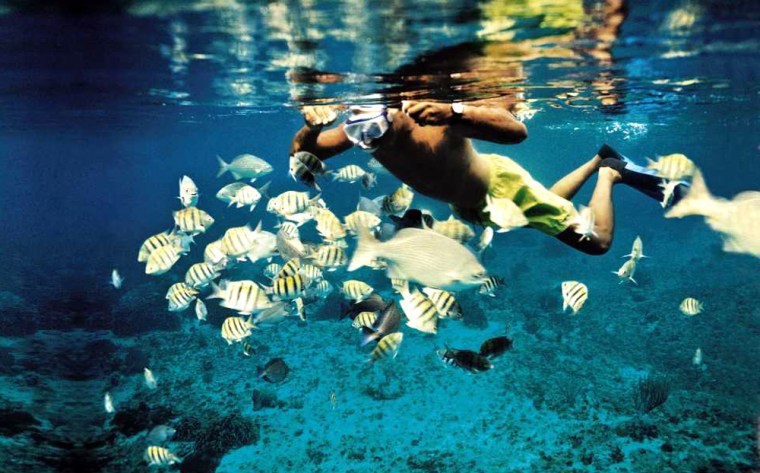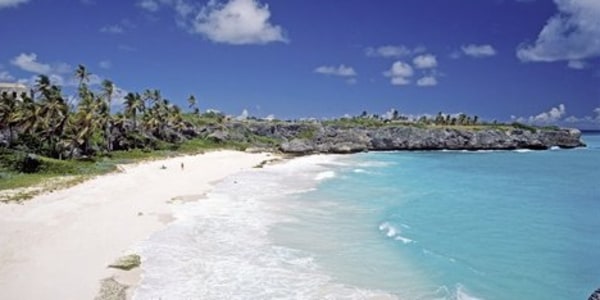In 1981 when I took my first Caribbean cruise, my travel agent touted Eastern Caribbean itineraries. "Unless you like watersports and hiking, there's nothing to do in the West," she advised. A couple of years later my first foray into Western Caribbean waters confirmed the relative popularity for cruise lines and passengers of East vs. West in those days. In contrast to the jammed dock and throngs of cruisers on the streets of Charlotte Amalie, on our port call at Cozumel only one other ship shared the harbor with us. Shopping was pretty much limited to local crafts and trinkets in either Georgetown, Grand Cayman or Cozumel, and Carlos 'n Charlies, during daylight hours, was primarily an eatery with a six-page menu of fabulous upscale Mexican cuisine. Even so, as an avid snorkeler and hiker -- and less than an enthusiastic shopper -- I could hardly concur that there was nothing to do in the West.
Indeed there is another factor in the rise of the West's popularity: the similar increase in the popularity of diving and snorkeling, since the Western ports are still considered havens for the mask-and-fin-set. Because snorkeling is an unregulated sport there is no way to track its number of participants. However, we can assume a relative correlation between interest in scuba diving and snorkeling, and keeping track of the number of scuba aficionados is easy. PADI (the Professional Association of Dive Instructors), the largest diver certification agency, has figures for numbers of scuba certifications issued. And those numbers are astounding: From its inception in 1967 to 1981, the point that I took that first Caribbean cruise, PADI had certified a total of 856,631 scuba divers. In 2004, alone, PADI certified 951,470!
Of course, there's always the "chicken and egg" issue: Did the rise in popularity of diving and snorkeling boost the interest in Western Caribbean itineraries or vice versa? In reality, the question is academic ... what really counts is that if you love to get wet and commune with the fish, there are some terrific opportunities along the Western edge of the Caribbean Sea, especially in places like Roatan and Belize, thus far under-visited by the cruise industry.
I offered some general guidelines in our first article in this series: , and since they apply equally well here, they bear repeating:
Overall Considerations The first question to ask yourself when choosing a cruise primarily with snorkeling or diving in mind is how much control of the program is in the hands of the cruise line. Are there onboard dive masters? Does the ship conduct its own dive excursions or does it sell commercial dive or snorkeling trips as just another shore excursion? And, if so, do the onboard dive masters accompany the passengers on the excursion? From our perspective, the more hands-on the cruise line is, the higher the rating.
Rent, own or borrow? Here's a simple rule of thumb: go from top to bottom; the higher on your body, the more good reasons for packing and bringing your own. Starting with the snorkel, itself, above all else, it's a matter of hygiene. Bottom line: that mouthpiece has been in a stranger's mouth. Passengers who stress over the threat of Norovirus and wash their hands every five minutes often don't give a second thought to plunking a publicly used snorkel in their mouth. Cozumel? Folks whose stomachs begin twitching at the very sight of a local ice cube, blithely accept the gear handed out by local Mexican operators, trusting, we suppose, that they wash the snorkels in Evian water. It should be noted that some cruise lines are offering new or sterilized snorkel mouthpieces through their shore excursion departments, but snorkels are inexpensive and take little room in suitcases. If you enjoy snorkeling, it's worth the investment. Masks are more personalized than most people think. Faces are different in shape and size. Use a mask too big and it will leak around the edges; use one too small and your vision will be limited. That adjustable strap once personalized for you should seldom require readjustment, unlike that mask you got from the ship's onboard dive department, which seemed previously to have belonged to a munchkin. Snorkelers needing corrective lenses will be happy to know that any decent mask has inserts available to reproduce any ocular prescription.
Fins are so generic that, unless you have very large or very small feet (or one of each), it's unlikely that you will fail to find suitable ones. They take a lot of room in your luggage, so don't bother investing.
Regarding ship design, if you are on a large or mid-sized ship there is little variance in design or ship's architecture that would make a difference for the logistics of diving or snorkeling. However, some small ships have transoms that fold down into "sports platforms," which will make the task of boarding Zodiacs and loading scuba gear for divers a much simpler task. Also, some ships have gear storage rooms and among those some will store passenger gear. Though not a major issue for snorkelers, divers will appreciate always having -- and this will seem oxymoronic -- a dry wetsuit to climb into, as well as having a more spacious and less pungent stateroom, which is likely to put a smile on their cabin stewards' faces as well.
How We Did the Ratings First, we chose arguably the best dive and snorkel areas for each location and picked the most accessible ports of call for each. Then we ranked the cruise lines calling at those ports based on ship design, level and quality of staff participation, and, finally, number, variety and value of available snorkel or diving excursions.
City, Island or Group: Belize Cayes
Best Sites or Areas: Ambergris Caye, Caye Caulker, Caye Chapel, South Water Caye, Goff's Caye and Turneffe Atoll. Of these areas, Ambergris Caye and Turneffe Atoll are the closest to Belize City.
Lush coral growth abounds in water with typical visibilities in the 100-foot range. Off Ambergris, Hol Chan Cut and Mata Cut dive sites are perfect for snorkeling or beginners' dives. Shallow reefs are bisected by natural channels through which tidal flow sweeps in small fish, plankton and other nutrients, which, in turn lead to an abundance of interesting sea life from farther up the food chain. Blue Creek is a similar site in Turneffe Atoll. Turneffe also sports several wrecks and many dramatic wall dives. Alas, the Blue Hole, Belize's most famous dive site, is too distant to be reached by cruise ship dive excursions.
Closest Port of Call: Belize City
Our Pick:
Why: The two finalists in our estimation were and , both of which have onboard PADI dive programs and instructors. RCI got the nod out of depth of experiences: they offer two choices of different two-tank scuba dives vs. Princess' one, and a wider range of snorkel and snuba excursions as well.
City, Island or Group: Cozumel Best Sites or Areas: Any of the reefs and walls on the western side of the island of Cozumel. The most popular are Palancar, Tormentos, San Francisco, Santa Rosa, Paraiso North, and, at the very south end of the island, Colombia Reef. In addition, and of special interest to snorkelers, is Chankanaab Park, which has plentiful shallow dive and snorkel opportunities, many reachable from the beach. (Chankanaab suffered major damage during 2005's Hurricane Wilma; check to determine if any areas of the park are still affected.)
Slideshow 11 photos
Marvelous Mexico
Another fun snorkeling site is Airplane Flats, right off the beach in front of the La Ceiba Hotel, which includes wrecks of a twin-engine airplane and an old wooden boat. Lastly, at least two cruise lines (and ) currently offer dive trips to the Chiken Ha Cenote, a deep, system of ultra-clear freshwater caverns in the midst of the mainland jungle.
What's There: Cozumel is most famous for two things: big currents and giant groupers. The currents are due to strong tidal flow passing through the narrowing passage between the island of Cozumel and the Yucatan mainland. Because of the force and constancy of the current, almost all Cozumel dives are drift dives, in which divers enter the water from an untethered dive boat, which follows them as they glide effortlessly with the current with very little finning required. When the diver runs low on air, he/she rises to the surface to be picked up by that dive boat.
Closest Ports of Call: Cozumel (San Miguel)
Our Pick: Princess
Why: Our vote goes to Princess for their onboard "New Waves" scuba program, not to mention the fact that they include a Chiken Ha Cenote trip in their excursions and the availability of a three-tank dive (on seven-night cruises), a rarity for cruise ship dive excursions. Princess also offers 15 different Cozumel shore excursions for which snorkeling is all or part of the experience, as well as helmet diving, snuba and "Discover Scuba," which gives non-divers the opportunity, after a brief training and checkout process, to try out scuba diving on an easy, safe, supervised dive.
City, Island or Group: Cayman Islands Best Sites or Areas: Anything along the Cayman Wall, Stingray City and Sandbar, Oro Verde Wreck, Balboa Wreck and Cemetery Reef
What's There: For snorkelers, there's Stingray City (Sandbar) and a number of organized boat dives on shallow reefs or wrecks. However, many good snorkel spots can be reached on one's own right from shore, including Cemetery Reef, a colorful, shallow little reef right off the Georgetown waterfront just a stone's throw from the tender dock. For that matter, many of the snorkel trips offered onboard, especially those to Stingray City and Sandbar, can be booked far more affordably through the ubiquitous throng of operators hanging around the tender terminal.
For scuba divers, the main draw is the Cayman Wall, which drops precipitously into the abyss. A decent percentage of cruise ship dive excursions make their first of two dives a wall dive, though generally, for reasons explained further on, not to the better, more dramatic of the wall's sites.
Typically, for the second dive, nearly every operator serving the cruise industry takes their flock to the wreck of the Oro Verde, a 181-foot freighter sunk in 1980. With a maximum depth of 50 feet it makes an excellent novice-friendly dive. The original Stingray City, which sits in 12 feet of water is a suitable, but hardly challenging destination for scuba divers and is offered as an excursion by most cruise ships. (Sandbar, which has waist-deep water, is now lumped together conceptually with Stingray City, but gets a hugely greater number of visitors, including most of the traffic from cruise ships.)
For the highly skilled scuba diver, I recommend booking dives independently from the cruise ship shore excursion department. Many of the better dives on the Cayman Wall are considered too challenging by cruise line management and so are seldom offered as shore excursions. An example is one of my favorite Cayman dives, Trinity Caves, which has an official maximum depth of 90 feet. But the maximum depth a diver reaches on sites like Trinity Caves depends on his ability to control his depth and buoyancy to maintain that level: the actual bottom is literally thousands of feet down! The cruise lines prefer dives that have an absolute bottom at that depth or less.
Closest Ports of Call: Georgetown, Grand Cayman Royal Caribbean
Why: While offering the same series of snorkel and scuba trips as the competition, RCI schedules the final open water checkout dives of their Sea Trek onboard PADI certification course at Grand Cayman -- not a bad choice. This Cayman dive experience culminates onboard classroom and pool practice sessions conducted on cruise days prior to the Cayman port call.
City, Island or Group: Bay Islands, Honduras
Best Sites or Areas: Walls and reefs along the north shore of the three main Bay Islands: Roatan, Utila and Guanaja. There are still some terrific less-visited sites on the south shore of Roatan and in the tiny Cayos Cochinos farther south, but these sites are unreachable on a typical cruise ship port call.
What's There: The barrier reef that starts in Northern Yucatan continues offshore along Honduras' Bay Islands. There are many wall dives that are, like Cozumel's, drift dives, but there are also areas along the reef where the current is far milder, and conventional boat dives are possible.
Slideshow 20 photos
Caribbean way of life
There are many areas -- some close to shore -- of shallow reefs suitable for snorkeling, and Anthony's Key Resort, which provides the lion's share of beach, snorkel and dive excursions for the cruise industry, conducts dolphin encounters, including in waist-deep water, snorkeling and a wall dive with accompanying dolphins. In addition, the Bay Islands are known for frequent sightings of whale sharks, though most of these occur off Utila, 18 miles from the west end of Roatan, and, at the time I filed this story, no cruise lines were offering snorkel or dive trips with these gentle leviathans. For those who want to explore this option further, contact (504-445-1306).
Closest Ports of Call: Roatan
Our Pick: A tie -- and
Why: Carnival gets our nod because they offer the "Certified Dolphin Dive" experience; offers the full panoply of snorkel, scuba and snuba trips, but they also offer a certified scuba shark feed dive at a depth of 70 feet.
South Florida-based Faber is a longtime contributor to Cruise Critic and also columnist for Cruise Critic's Cruise News & Reviews. Beyond our publications, Faber's work has appeared in a myriad of outlets, including Cruise Travel Magazine, "The Miami Herald" and "The Total Traveler Guide to Worldwide Cruising."


